There are numerous dermatology groups employing over 700 dermatologists that are always on the lookout to purchase new dermatology practices. They know that the sector is extremely fragmented, and they’re able to bring savings and efficiency to generate a profit. This is an extremely intricate subject, so bear with me this may require a bit of a reading. Entrepreneurial skin doctors originally set up these groups for sensible reasons, for example, bargaining power and cost efficiencies. Now, with low-cost money (consider interest charges ) existing in the equity markets at large quantities, big businesses are wanting to earn a better, secure yield on their money by purchasing those groups and commoditizing them.
I was said that being a portion of an investor-owned group clinic is one of the options open to clinics and is something relatively new to think about.
To do this, private equity companies partner with dermatology and other clinics in a trade that optimizes the alignment involving the clinic and investor, maximizes fiscal flexibility and positions the recently formed firm for monetary growth.
Investors decide that a clinic’s worth according to a multiplier, which may change, implemented to Earnings Before Interest, Tax, Depreciation, and Amortization (EBITDA). It might be a good idea to calculate your clinic’s worth after evaluating your finances and the worth of the valuable equipment in your clinic, such as your low-level laser therapy machine or your UV phototherapy machine.
It also has to be clarified that EBITDA refers to industry standard measure of free cash flow.
It has been stated that in many doctor practices, there’s absolutely no EBDITA per se and there’s only doctor income. The quantity of income a doctor or group of doctors earn over and beyond the standard (whatever that is) is exactly what could be re-characterized as sold and earnings.
Fiscal buyers considering dermatology practices comprise companies seeking to acquire platforms at the dermatology area and present businesses needing to build scale. While little practices are most likely to sell to based consolidators, an established dermatology group has the choice of aligning with a brand new entrant.
So who can this be a fantastic bargain for? Older doctors, about 5 years before retirement, might have the ability to capitalize on the value — typically calculated by EBITDA (an organization’s earnings before interest, taxation, depreciation, and amortization) — and also market their own practices over time. EBITDA is a rough quote of a clinic’s profitability. Remember that a couple of decades back, some groups of people were only begging to locate a purchaser to escape or shuttering their workplaces and walking into retirement with a hefty sum of money.
Among the biggest benefits is getting a lump sum payment for the majority of the clinic (generally five to seven times larger than EBITDA), which can be treated as a capital gain for tax purposes. That means a 20% tax rate as opposed to 39.6 percent. Normally, sellers receive 60 percent of their five to seven days EBITDA worth upfront along with the remaining 40 percent is your equity stake from the group. This bet might be worth down the street if the clinic is repurchased with a bigger fish, as normally happens.
Younger doctors normally have less to gain, because they might not have an equity stake in the clinic being marketed. Even the people who do will probably be employees. Workers may have the chance to purchase or opt for an equity position afterward. One of the other benefits might be that they do not have to worry about worker productivity and other managerial concerns so it might lift some work-related pressures off their shoulders.
There are advantages of partnering with an increase equity company. One of these: it could position physician spouses to decorate equity value from the custom. It may free dermatologists from debt or from worries regarding the future of medication and supply a more predictable career progression. Sellers may maintain some ownership and so have the chance to take part in the greater equity value as the team grows in size and endurance.

The buyout money isn’t a present, and you’ll pay the majority of it back within the normal five decades or more of minimal employment time given from the market contract. The equity companies estimate your wages at 40%, the overhead at 40 percent, and also their gain at 20 percent.
Which are the apparent disadvantages? You won’t earn as much in salary as you did earlier (remember that 20% worth of profit mentioned above), you become a worker, and you eliminate flexibility and control. You have to work as many days generally as you did at the 3-year period prior to your buyout, and you don’t have to supervise your workers as before. They’ll be handled by the purchasing firm’s human resources department, which might make a few things better for you.
You might have new workers assigned to you which you generally wouldn’t, and it’s important in your discussions that you just spell out what sort and how many workers you’re ready to supervise.
You’ll be strongly encouraged to ship your pathology and Mohs instances to additional members of this category, if available. You have to warrant big purchases (for instance, brand new lasers). The group will purchase your current gear, ideally for fair market value.
So is selling your clinic a fantastic deal for you? Apparently, it is dependent on a number of factors. It might be a good idea to consult your local business coach before making any hasty decisions.








